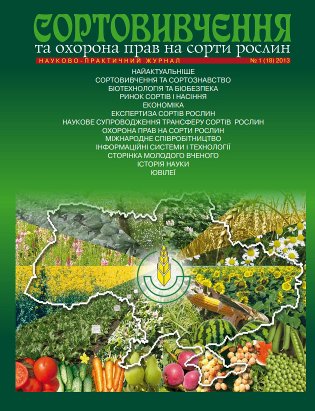Apomixis and the problem of obtaining haploids and homozygote diploids in pear (Pyrus communis L.)
DOI:
https://doi.org/10.21498/2518-1017.1(18).2013.58699Keywords:
стимулятивний партеногенез, гаплоїд.Abstract
The article highlights results of research over simulative apomixes in pear and its utilization for obtaining haploids and homozygote diploids. It has been established that over 50% pear varieties with failed remote hybridization are capable of generating seeds of apomictic origin producing diploid plants. Genotypes displaying maximal inclination to apomixes have been singled out. Apomictic pear seedlings obtained from foreign pollination within the limits of the same combination are inherent in profound morphological diversity. Fruit-bearing apomicts originated from one and the same maternal plant differ to the same extent as hybrid seedlings of the same family. Genetic markers have enabled to establish that these are embryo sacs in which meiosis has completed that give rise to apomictic seeds. In vitro method as used for the purpose of increasing apomictic plants output has been illustrated. The greatest induction of apomictic shoots in vitro has been reached by alternation of BAP cytokinin at concentration of 1mg/l and 2 mg/l on the background of GA3 amounting to 1,5 mg/l. Grafting with shoots in vitro on non-sterile rootstocks of pear (Pyrus communis) has increased the output of plants up to 80%. A cytological assessment of 9 apomictic samples is provided. The cytological analysis of samples of apomictic forms has certified the presence of simulative haploid parthenogenesis in pear.Downloads
References
Навашин, М.С. Новая возможность в селекции / М.С. Навашин // Селекция и семе оводство. – 1933. – No 2. – С. 11–16.
Хохлов, С.С. Гаплоидия и се екция / С.С. Хохлов, В.С. Тырнов, Е.В. Гришина [и др.]. – М.: Наука, 1976. – 222 с.
Murahami, Y. Biotechnology of fruittrees / Y. Murahami // Farmg. Japan. – 1987. – Vol. 21, No 1. – P. 27–36.
Dayan Wang, Gao-lin Gui, Jang San Sun. Tissue culture of . fruit crops in China// Hortscience. – 1988. – Vol. 23, No 6. – P. 962–965.
Hanre V. Nutzung biotechnologisches Verfahren fur die Obstzuchtung// Landwirtschaftwissenschaft. – 1990. – No 292. – S. 193–199.
Жуков, О.С. Методические реко ендации по получению растений регенератов плодовых пород в культуре пыльников / О.С. Жуков, О.Я. Олейникова, Н.И. Савельев. – Мичуринск, 1994. – 36 с.
Lespinasse Y., Godicheau M., Duron M. Potential value and method of producing haploids in the apple tree Malus pumila Mill// Acta Horticulturae. – 1983. – Vol. 131. – P. 223–230.
Zhang J.X., Lespinasse Y., Chevreau E. Obtention de plantes haploides de pommier (Malus domestica Borkh) issues de parthenogenese induite in situ par du pollen irradie et culture in vitro des pepins immatures// C.r.Acad.sci. – 1988. – Vol. 307. – P. 451– 457.
Laurie, D.A. The production of haploid wheat plants from wheat x maize cross / D.A. Laurie, M.D. Bennett // Theor.Appl. Genet .– 1988.– Vol. 76. – P. 393–397.
Inagaki M., Henry Y., Buyser J. Comparison of haploid production efficiency through anther culture and intergenetic crossing in three wheat varieties and their Fl hybrids / Japan J. Breeding. – 1987. – Vol. 57. – No 4. – 474 p.
Suenaga K., Nakajime K. Efficient production through crosses between Japanense wheat and maize (Zea mays7) / Plant Cell Reports. – 1989. –Vol. 8. – P. 263 – 266.
Чистякова, В.Н. Экспериментальная гаплоидия как средство интенсификации генетико-селекционных работ / В.Н. Чистякова, Э.Д. Неттевич, Т.В. Гуляев // Совершенствование селекционно-генетических процессов при выведении сортов зерновых и зернобобовых культур в Нечерноземной зоне. – Москва, 1990. – С. 3–12.
Чистякова, В.Н. Метод ускоренного получения гомозиготных линий мягкой пшеницы и неполных 56 хромосомных пшенично-пырейных амфидиплоидов при внутривидовой гибридизации / В.Н. Чистякова. // Совершенствование селекционно-генетических методов при выведении сортов зерновых и зернобобовых культур в Нечерноземной зоне. – М.: 1990. – С. 3–12.
Долматов, Е.А. Стимулятивный апомиксис и проблема получения гомозиготных растений у груши / Е.А. Долматов // Селекция и сорторазведение садовых культур. – Орел: ВНИИСПК, 1996. – С. 11–123.
Долматов, Е.А. Апомиксис у груши и перспективы его использования / Е.А. Долматов. // На благо отечественного садоводства (150 лет Всероссийскому НИИ селекции плодовых культур). – Орел: «Тургеневский бережок», 1996. – С. 165–167.
Долматов, Е.А. Апомиксис и экспериментальная гаплоидия у груши / Е.А. Долматов, Н.И. Панова // Селекция и сорторазведение садовых культур. – Орел: ВНИИСПК, 1998. – С. 276–280.
Долматов, Е.А. Изучение морфологической неоднородности апомиктического потомства груши / Е.А. Долматов, Е.Н. Седов, Н.И. Панова, Г.А. Седышева // Доклады РАСХН, – 1998. – No 4. – С. 15–16.
Downloads
Published
How to Cite
Issue
Section
License
Copyright (c) 2013 Ukrainian Institute for Plant Variety Examination

This work is licensed under a Creative Commons Attribution-ShareAlike 4.0 International License.
Starting in 2022, the copyright to the publication remains with the authors
Our journal abides by the CREATIVE COMMONS copyright rights and permissions for open access journals.
Authors, who are published in this journal, agree to the following conditions:
- The authors reserve the right to authorship of the work and pass the first publication right of this work to the journal under the terms of a Creative Commons Attribution License, which allows others to freely distribute the published research with the obligatory reference to the authors of the original work and the first publication of the work in this journal.
- The authors have the right to conclude separate supplement agreements that relate to non-exclusive work distribution in the form in which it has been published by the journal (for example, to upload the work to the online storage of the journal or publish it as part of a monograph), provided that the reference to the first publication of the work in this journal is included.

























 Ukrainian Institute for Plant Varieties Examination
Ukrainian Institute for Plant Varieties Examination  Селекційно-генетичний інститут
Селекційно-генетичний інститут Institute of Plant Physiology and Genetics of the National Academy of Sciences of Ukraine
Institute of Plant Physiology and Genetics of the National Academy of Sciences of Ukraine
 The National Academy of Agrarian Sciences of Ukraine
The National Academy of Agrarian Sciences of Ukraine